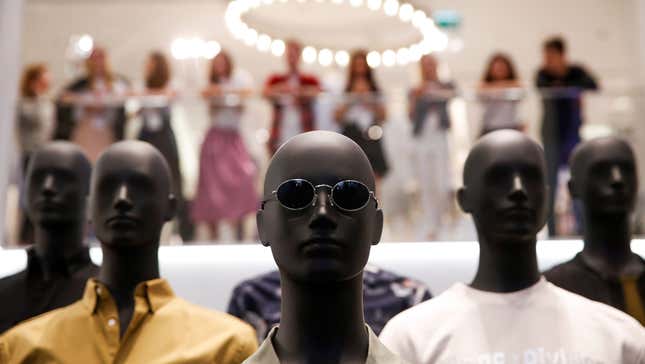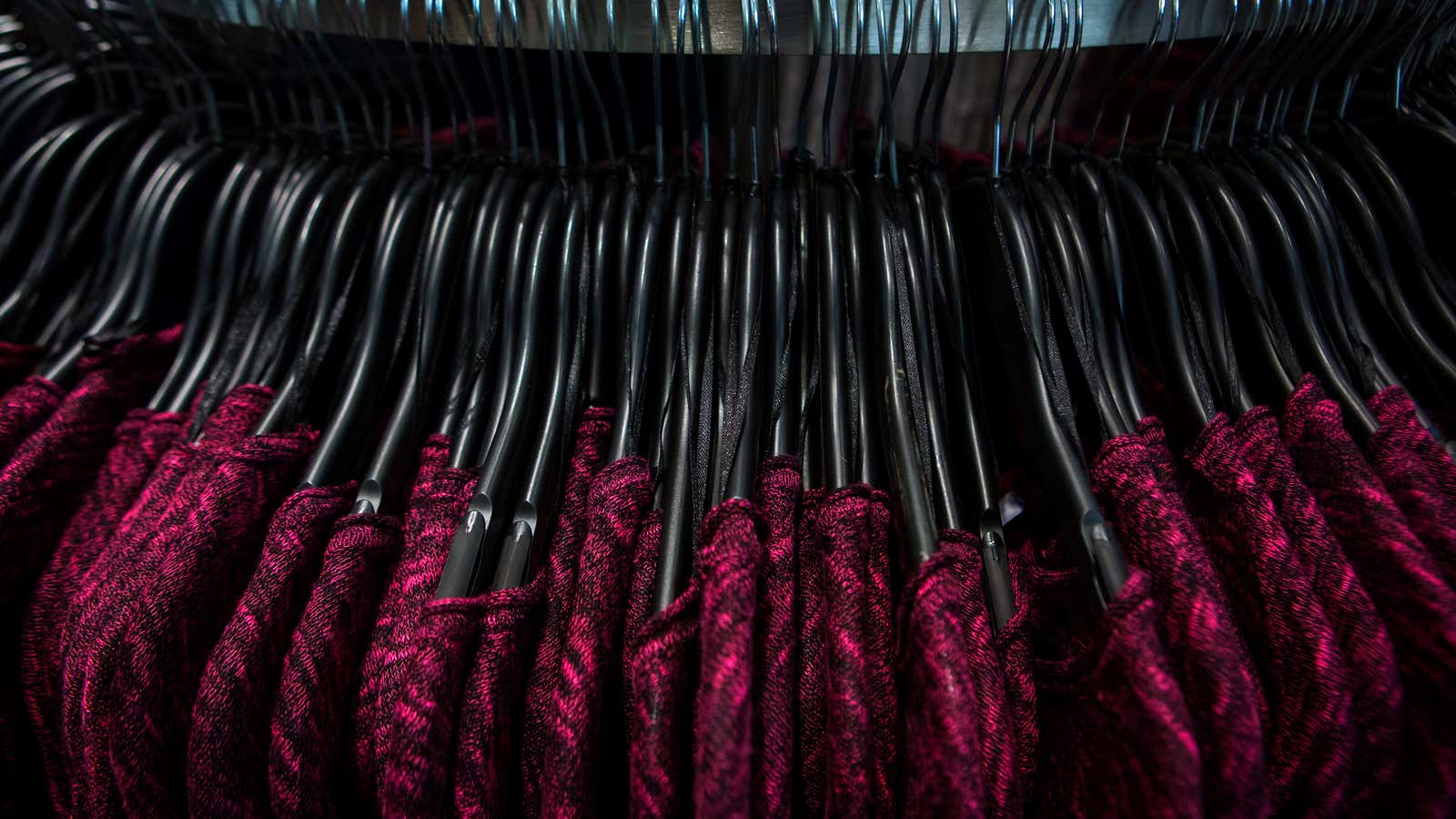I’m not sure if it was the crowds, the harsh lighting, the cheap fabric, or the overwhelming choices sprawled before me. But last December, staring at rows of scarves in an H&M in London, I decided I was fed up.
I was in the city temporarily, and I’d gone into the store to buy a few items that I had forgotten to pack. What I would have once taken as a simple sign of disorganization—the fact that I was spending money on clothing I already had—now felt like wastefulness, and left me feeling slightly ill. With New Year’s Day around the corner, I decided to give up fast fashion for a year.
Fashion is a $2.4 trillion industry, according to estimates by McKinsey, and fast fashion, a big chunk of it, has completely reshaped the way we shop. Brands like H&M, Zara, and Forever 21, with their lightening quick responses to trends, speedy deliveries to stores, and ridiculously low prices, have outpaced competitors for years. But fast fashion is also a dirty industry, consuming massive amounts of natural resources and rife with unsafe labor conditions and exploitative practices.
Still, giving up fast fashion isn’t the easiest choice. I was addicted to what our fashion reporter Marc Bain calls the “sad cycle of compulsive shopping, guilt, and regret” brought about by shopping at places like these. But somewhere along the line, browsing for clothes had stopped being fun and started feeling mindless. I wasn’t prioritizing finding items I really liked, and I was getting rid of clothes as quickly as I was acquiring them. This was partly the result of mistrusting my own fashion sense, but it was also about the way I shopped. Why care about how well-made or good-looking a garment is if you can just replace it at minimal cost to yourself?
And so I resolved to ignore the bright shop windows and glittery mannequins and bring some “mindfulness” to my wardrobe. My resolution was in part inspired by author Ann Patchett, who wrote a popular New York Times article (paywall) laying out her decision to try out a complete shopping ban. “The unspoken question of shopping is ‘What do I need?,” Patchett writes. “What I needed was less.”

My attempt was imperfect, and at times involved some sneaky strategies. I hadn’t considered that I might need new underwear, so a very strong hint of a Victoria Secret sale to the husband for Valentine’s Day helped in that regard. When a friend texted asking for suggestions about places where she could donate clothes, I asked if she’d let me look through her castoffs first, scoring a winter wardrobe refresh on the way. I frequented multiple clothing swaps, and asked for a gift card to Buffalo Exchange for my birthday. Toward the end of the year, I relaxed my rules and let myself buy a few secondhand fast fashion duds at charity shops.
I also broke down at the end of February, paying $15 for a pair of socks to wear while skiing. (If I had to choose between principles and hypothermia, retaining my toes seemed the wiser choice.) I did it again in October, when I popped into Old Navy to buy a pair of tights.
For the most part, the shopping ban came as a relief. Participating in clothing swaps gave me permission to try new things without the guilt or financial dent of something not working out. At a clothing swap in May, for example, I picked up several items that I thought suited me, only to reconsider when I tried them on at home. I’ve kept a Banana Republic coat, Nine West sandals, and an H&M sweater in heavy rotation; the other items I recycled at another swap, guilt-free.
On the other hand, when I really was going to fork out cash, say at a secondhand store, the ban forced me to focus on exactly what I needed, which made the shopping experience less overwhelming and more goal-oriented. I also learned how to pack better, knowing that I couldn’t rely on a quick trip to the store. I hope in the year ahead, with a more focused approach, I can start to think about the items I’d really like, as opposed to being subject to rapid trend cycles.
I’m not alone in seeking this feeling of freedom. Increased awareness of labor conditions and the environmental impact of this fashion churn, as well as a desire amongst some people for more sustainable living, has seen some shoppers turn their backs on the retailers. At one point this year, H&M had stockpiled $4.3 billion in unsold clothes. As Elizabeth Paton writes for the New York Times, “In the digital era, the challenges around offering trendy apparel before it goes out of style have mounted, particularly as growing numbers of shoppers choose to buy from their smartphones and become more quality conscious.”
But my fast fashion-less year also made me realize how ubiquitous these stores are, and how difficult it is to avoid them. Doing so requires effort at every turn: you have to buy fewer things of higher quality and price, take better care of your clothes, repair them instead of throwing them away, and think carefully before purchasing an item. I also recognize that it’s a position of privilege to even think about spending more to have less.
My year off taught me how to pause before buying. My resolution for 2019 is to learn how to shop better. Marc’s suggestion is to buy a piece of clothing “so expensive it hurts,” a guideline he follows to try reduce his contribution to the wastefulness of fast fashion. “The point is to make you pause and ask yourself, “How much do I really want this?” he writes.
What I really want at the moment is a classic, long-lasting swimsuit that looks good and makes me feel even better. I think I’ll start there.
Correction: An earlier version of this article described fast fashion as a $2.4 trillion industry, instead of part of the estimated $2.4 trillion fashion industry.
